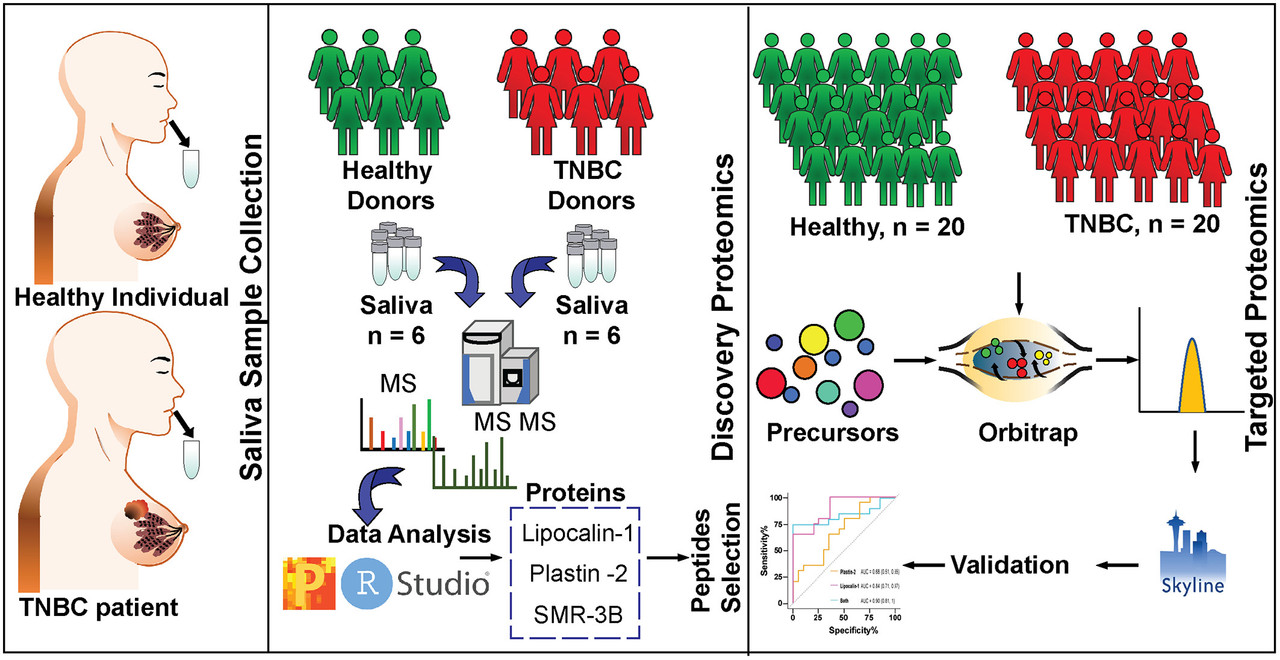Science
Related: About this forumA saliva test for triple negative breast cancer?
While working on a project for my job, I stumbled upon this paper which is not related to the syndrome I'm currently studying: Kuldeep Giri, Sudipa Maity, Kiran Ambatipudi, Targeted proteomics using parallel reaction monitoring confirms salivary proteins indicative of metastatic triple-negative breast cancer, Journal of Proteomics, Volume 267, 2022, 104701.
Triple negative is the really bad form of breast cancer; we're making progress, but by no means are we "there yet."
We do have very powerful analytical tools, and the degree of sophistication I've seen in just the last five years in mass spectrometry just blow my mind; I can hardly keep up.
Unfortunately I can't spend much time on this paper, but here's a few excerpts:
...Breast cancer is a biologically and molecularly heterogeneous disease originating from the breast [3]. Based on the gene expression pattern of four well-established biomarkers, such as estrogen receptor alpha (ER? ), progesterone receptor (PR), human epidermal growth factor receptor 2 (HER-2), and proliferation-associated nuclear antigen (Ki-67), breast cancer tumours have been categorized into five distinct subtypes, i.e., Luminal A and B, Triple-negative, Normal-like, and Her-2 enriched breast cancer [4]. This molecular/clinical subtype classification is often used to decide the appropriate therapeutic strategies and set the critical reference for prognosis [5].
Among the different breast cancer subtypes, triple-negative breast cancer (TNBC) is a heterogeneous set of cancer characterized by no ER/PR and Her-2 protein expression. It is the most aggressive subtype and grows faster than other subtypes. It has a poor prognosis with no effective targeted therapy due to the absence of any receptor status [6,7]. TNBCs mainly affects younger women (less than 50 years of age) with a higher frequency of p53 mutations and at a higher risk of death by distant recurrence, especially during the first 3–5 years of follow-up. Importantly, TNBC metastasizes predominantly to visceral organs than bones, including a higher incidence of cerebral metastases and a higher rate of local relapse in patients than any other subtypes...
After some other stuff, the authors discuss mass spectrometry and breast cancer and give their research goal:
Due to the propensity of ease of collection and enrichment of low abundant proteins in saliva, we used an MS-based label-free untargeted approach for relative quantitation coupled with absolute targeted quantitation using parallel reaction monitoring (PRM)-based assay to investigate potential salivary protein markers associated with TNBC and its metastasis...
A graphic from the paper:

There's a lot of cool stuff in this paper that I regrettably won't have time to share, but it's promising, but needs confirmation:
Our study is designed in the context of potential marker discovery in non-invasive bio-fluid saliva from TNBC patients utilizing targeted proteomic assays. While our developed assays are subsequently evaluated across multiple independent cohorts, substantial work is still required by validating these proteins in larger independent patient cohorts, preferably in longitudinally collected samples and additional assay optimizations. Here, we provide the first work utilizing PRM-MS to systematically identify these novel salivary proteins as potential markers to distinguish and indicate TNBC progression in a medium-sized cohort...
It's promising, I think, a lead toward large scale simple screening.
Have a nice day tomorrow.
elleng
(139,182 posts)Deuxcents
(21,766 posts)I have a dear friend who just completed 33 radiation treatments for cancer of the saliva glands. I’m wondering if tests need to be done on that first before testing for breast cancers. Thankfully, medicine n science are progressing on this horrible cancer..and all cancers, for that matter.
NCjack
(10,297 posts)of a new abnormal feature by self-examination. Everytime you shower or bath.
You cannot depend on your partner alone for detection. The new abnormality may be a new lump or a new depression. That is right -- a depression!
NNadir
(35,572 posts)...in this case, as the authors make clear.
Given the expected false discovery rate that one can expect, it should be considered only for screening purposes and be subject to confirmatory testing.
Notably, it only covers, even if subject ultimately to regulatory approval, a stage to which it will advance if the development pans out, triple negative, and not the other types of breast cancer.
It should prove useful for preparing surgeons and pathologists for what they may see on biopsy and tumor morphology.
This test depends on access, at least for now, on high resolution mass spectrometry, expensive instruments, but almost certainly can be moved to less expensive and more available (in CLIA labs) triple quad mass specs if it is fully validated.
It's a lead, not a result. For now everyone should do what is confirmed to work best, including self examination.
Wounded Bear
(61,723 posts)any non-invasive test for cancer should be investigated thoroughly.